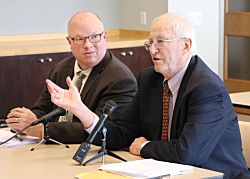Langley discusses medication issues with Ohio Racing Commission
March 30, 2015,from the USTA Communications Department
Columbus, OH — USTA President Phil Langley, accompanied by Executive Vice President Mike Tanner, presented the USTA’s position on a number of medication issues to the Ohio State Racing Commission at their monthly meeting on Monday afternoon (March 30) at the Riffe Center in Columbus, Ohio.
At the previous commission meeting on Feb. 21, Chairman Robert K. Schmitz invited representatives of the U.S. Trotting Association, national and state branches of the Horsemen’s Benevolent & Protective Association, and the Ohio Harness Horsemen’s Association to address the commission.

USTA/Mark Hall photo
USTA President Phil Langley (right) and Executive Vice President Mike Tanner presented the USTA’s position on a number of medication issues to the Ohio State Racing Commission.
Langley focused on the need for uniform but separate medication rules for the different breeds, the use of therapeutic medications and USTA research on cobalt. He emphasized that in harness racing, the horses race much more often than Thoroughbreds and that harness racing doesn’t have the same problems with breakdowns.
“The USTA strongly believes in uniform medication rules,” said Langley. “But we believe in uniform rules for harness racing and uniform rules for Thoroughbreds, but different rules. The way we race is not compatible with the way they race. We would like the rules to reflect the harness use, not the Thoroughbred use.
“Recently, Ed Martin from RCI (Association of Racing Commissioners International) has indicated that they have no problem with separate rules.”
Langley discussed a USTA-funded research study on cobalt conducted by Dr. George Maylin from the New York Drug Testing and Research Program at Morrisville State College with assistance from Director Dr. Karyn Malinowski and Associate Director Dr. Ken McKeever from the Equine Science Center at Rutgers University.
He informed the commissioners that the USTA is planning a new study with that team of equine experts.
“Now we going to commission a new study with Drs. Maylin, Malinowski and McKeever to see exactly what cobalt does to horses,” said Langley. “One of the challenges is that the scientists have to figure out how to test horses that are racing.”
When asked by Chairman Schmitz for the reason that the USTA resigned from the Racing Medication and Testing Consortium in September 2013, Langley cited the USTA’s $100,000 annual contribution being made to an organization that refused to consider harness racing’s issues.
“Our money could be used better for studies on harness racing than for funding the RMTC who were not considering harness racing,” explained Langley.
The Ohio State Racing Commission is collecting information prior to consideration of model medication rules proposed by the Association of Racing Commissioners International. The commissioners heard presentations by RCI President Edward J. Martin and Dr. Dionne Benson, executive director of the Racing Medication and Testing Consortium, at their February meeting.
According to Chairman Schmitz, the commission will invite veterinarians and scientists to present in the next two months.
- OSRC hears presentations on model medication rules and testing procedures (Tuesday, March 31, 2015)
Presentations by the USTA’s Phil Langley and Mike Tanner, along with the HBPA’s Dave Basler and trainer William Cowan, and the OHHA’s Renee Mancino and trainer Virgil Morgan Jr. highlighted the Ohio State Racing Commission monthly meeting on March 30.
- Veterinarians to speak at next OSRC meeting (Monday, April 13, 2015)
Five veterinarians have been invited to speak at the Ohio State Racing Commission monthly meeting to discuss possible medication practices for Ohio horse racing.
